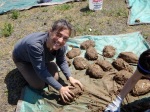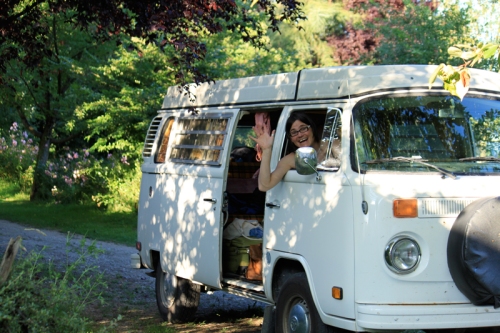For one month I am staying at the Fraser Commons Cooperative Farm in Aldergrove, BC. This is a 20 acre organic farm which supports a market garden business, two main households and 4 cabins. Almost everything on the land is considered the commons – equally shared amongst everyone. Equally enjoyed and equally worked and maintained by everyone on the land no matter where you live or what work you do – the commons is very precious and appreciated by the entire group.
It was my goal to stay at a cooperative homestead to learn how a cooperative farm was run and also to experience organic farming on a relatively small scale. The property has over 9 different beds and each bed has about 50 rows of vegetables with no more than 2 or 3 rows of the same thing together. There are over 5 poly greenhouses and two salad shacks with washing stations, freezers and coolers. The farm began with 10 acres and the original company ‘Glorious Organics’ has been running for about 30 years. You can read more detail on the history of this farm through a couple of websites which I will list at the end of the article.
The house I am staying in has 5 others staying here as well as the glorious organics office. The other house has 6 residents including two kids. There are a number of different visitors and workers living on the land as well – I am one of them! Everyone pays one set price to live here no matter the size, shape or location of their room – all kitchens and general living spaces are considered common shared spaces. Some general spaces are never visited by anyone but the sole occupant of the space, like the cabins for instance. I will be living in my VW Van and most likely I won’t wake up with someone sitting in my living room J
It is a wonderful experience to share space with others who each have their own thing going on but yet have a shared interest in the health of the land and the home. In the house I share there is someone different who cooks a meal every night. You can sign-up to join the meal or do your own thing. The house buys bulk grains, dairy and meat and eats vegetables off the land. This keeps the cost of food down by quite a bit. There are shared trips into the city to save on gas and the tools only have to be bought once. There are two carpenters who live on the land and one of them is a blacksmith as well. There is a horticulturalist/permaculturalist specialist, a bookkeeper and a beekeeper and a chicken keeper as well. Someone is testing bio-char, someone is building an outhouse, someone else is managing the farmer’s market work. Everyone shares their skills for the common good of the farm and garden business. There are bees, an orchard and chickens as well. There is lots of preserving done in the fall and all the goods are shared throughout the winter.
It seems to me, that people here understand how precious this living situation is and take care to contribute generously and to only take their fair share. It happens naturally and what doesn’t happen naturally, there are rules and regulations to refer to when needed.
URBAN CO-OP
What lessons can we take to the city? Why can this not happen amongst 4 to six households within walking distance to each other? I always thought this would be a great model for sharing in the city. People do not need to forfeit rights to their own property or become farmers or give up their day jobs. Nothing of the sort needs to happen in a successful urban co-op. Ideally the households will be within walking distance of each other so the surrounding public space could be considered the shared commons. The ‘commons’ becomes all the public space in and around the community. A very diverse set of skills and assets within 6 households are then bartered and shared amongst each other. Through this model we save on all resources: money, time and space. We create a reason to visit each other, reduce our impact on the environment and introduce more diversity into our lives. Time has been saved with less shopping, making and working and once we all start caring more for our neighbors we start to take better care of the commons. Less tax money is spent on jobs that can easily be done by local residents for free. The benefits are enormous with urban cooperatives and the risks are few. Your co-op needs to start with some well written set of expectations and regulations. Exit and entry into the co-op need to be considered and flexibility needs to be incorporated into any model.
If you would like to start a cooperative in your neighborhood and you are starting at the very beginning of just getting to know even one person in your neighborhood then here are some suggestions for you to follow:
- Get out of your house and out of your car.
- Walk around your neighborhood slowly. It is important that you don’t appear to be rushing off some where else.
- Take note of what is growing in the yards and on the balconies of your neighbor’s places.
- Walk around with a clip board and take notes in front of any house that looks interesting.
- Say hi to anyone who is outside.
- Do this every day or evening.
- Soon someone will ask you what the heck you are up to.
- Tell them what you like to do or have to share and list what you need from someone else. For example: Tell them you bake sweet and savory pies and you are looking for someone in the area who grows berries and herbs. Or tell them you have a lawnmower to share and are looking for someone who can share a weedwacker with you.
- It really just explodes from here. Once you have approximately 6 households, suggest an official co-op with written regulations and expectations, etc. (as listed above).
If you know someone in your neighborhood already then sit down with some tea and discuss the possibility of sharing amongst yourselves and with others. If you belong to a neighborhood group such as a school or church then try there as well. Maybe you have a community garden – this is a great place to make co-op connections.
It will take some time, trial and error to get your co-op formed and working smoothly, but your efforts will be well worth it.
Fraser Commons Farm: http://blog.conservancy.bc.ca/agriculture/programs/conservation-partners-program/our-partners-lower-mainland-region/fraser-common-farm-cooperative-aldergrove/
http://www.frasercommonfarm.com/Fraser_Common_Farm/Fraser_Common_Farm_Co-op.html
Author: Jacqulynn Mulyk








